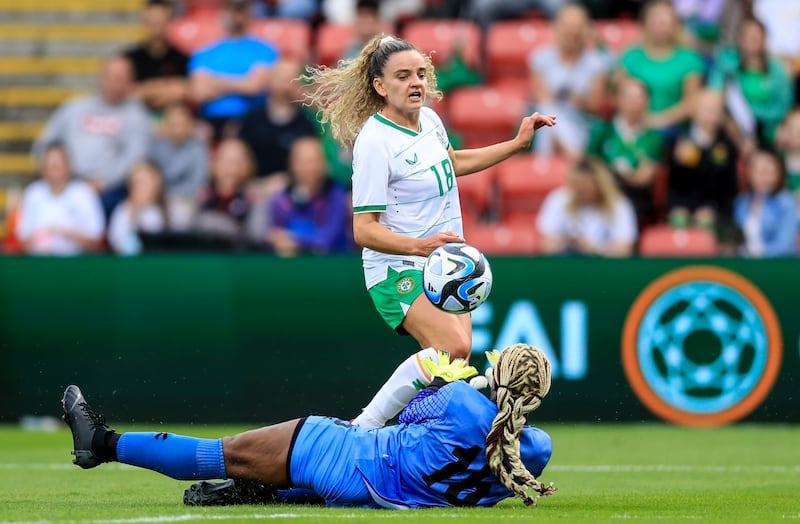A clear divide appears within the Republic of Ireland’s World Cup squad. Starters and substitutes. This will be confirmed by the team that faces France next Thursday in Tallaght stadium, and the 11 who finish against Hervé Renard’s side. The others are effectively travelling to next month’s tournament in Australia and New Zealand as injury cover.
“France is our last [home] game before our first World Cup, that is a key,” said Ireland manager Vera Pauw. “It’s all about everything coming together so we will start with our best team.”
If Aoife Mannion had avoided an MCL knee injury at Manchester United training last month, the starting XI would rattle off the tongue. Another centre half must sit beside Louise Quinn and Niamh Fahey as midfield trio Sinead Farrelly, Denise O’Sullivan and Megan Connolly seek out Katie McCabe, Heather Payne, Marissa Sheva and Kyra Carusa on the counterattack.
That, in a nutshell, is the Irish game plan.
RM Block
[ Mary Hannigan’s player-by-player guide to Ireland’s Women’s World Cup squadOpens in new window ]
“Everybody makes a joke by saying we love defending,” said Pauw. “It’s not that we want to be pushed back, we are pushed back because we didn’t have a target player.”
With Carusa up top and Sheva in support, the manager promises “a completely different style of play.”
Courtney Brosnan will start in nets but Pauw has appeased her goalkeeping coach Jan Willem van Ede by bringing a fourth stopper, for training purposes only, as uncapped Londoner Sophie Whitehouse is included ahead of players who dreamt about this moment from a young age.
Leanne Kiernan and Megan Campbell spring to mind. Then again, travelling as one of three ‘training players,’ without being entitled to the €27,400 in Fifa prizemoney is a form of torture in itself. Whitehouse is joined in this category by Birmingham City duo Harriet Scott and Jamie Finn.
As excitement levels build towards the World Cup opener against the hosts in Sydney on July 20th, memories of these emotionally charged 48 hours will fade. Unless Ireland return home from Australia without a goal. Or the masterplan to use McCabe as an attacking wing back misfires.
Recent history shows that Irish teams employing three centre halves and wing backs without the ability to retain possession are quickly hemmed in by the opposition. See how Callum O’Dowda was exposed in Athens.
Pauw cannot be accused of dithering but her decision to leave Kiernan and Campbell behind when the team flies to Brisbane on July 7th could come back to haunt the coach who guided her native Netherlands to the semi-finals of Euro 2009. Particularly the exclusion of Kiernan, who at 24-years-old possesses all the attributes to score a famous goal against Group B opponents Australia, Canada or Nigeria.

Pauw ruthlessly shut down this possibility, opting to bring four forwards and nine defenders.
In a double blow for Kiernan and Campbell it was revealed that neither player is injured. The management examined the sports science before deciding they would lack match fitness despite the Liverpool pair being known entities, bringing grit and talent in equal measure. But now, the former’s eye for goal and latter’s throw-ins have been stripped from the squad’s arsenal.
“Unfortunately, it’s their football fitness,” Pauw explained. “The balance is so good, I’ve never had that before in a team that I’ve coached.”
In fact, it was the promotion of Izzy Atkinson and demotion of Finn that gave the Irish management a sleepless night. “That has been the hardest decision,” said Pauw. “Other players have jumped up a level as you saw against Zambia and that prompts tough decisions.”
Atkinson, like Sheva, Farrelly and Claire O’Riordan, was not part of the squad during qualification, while others like Lucy Quinn, Diane Caldwell and Ruesha Littlejohn are selected largely on reputation and perhaps personality.
Atkinson, the 21-year-old West Ham United winger, does represent a link to grassroots football via Rush Athletic, Enniskerry FC and Shelbourne, but five of the squad were born in America, another five in the UK.
When the dust settles, some inspirational stories will rise to the surface. Take cancer survivor Chloe Mustaki or Farrelly, who lands into camp on Thursday from her first season at NJ/NY Gotham in the NWSL after a seven-year hiatus from the game.
Pauw had been monitoring the return of the 33-year-old from Havertown, Pennsylvania before giving Farrelly her international debut against the USA last April.
“We were already in talks with her during the summer before we qualified. I was open about that. You know the background, the car accident and coming back to the game.
“She took six months to return to training so I couldn’t find a lot of footage. We were completely open about what we’d get here. Then she sent a first video of a small-sided game she’d played with her university. At that moment, I said to my husband [former Dutch women’s coach Bert van Lingen], ‘come and have a look here’. Just those few touches; we saw it against USA, how she buys time for others, not herself.
“She says it’s like starting again. Although she’s in her 30s, her body feels like she’s in her 20s. You can see progress with every touch she makes. We can see that growth in sharpness, speed and defensive qualities. We saw those touches against the USA. There was no doubt about her.”




















